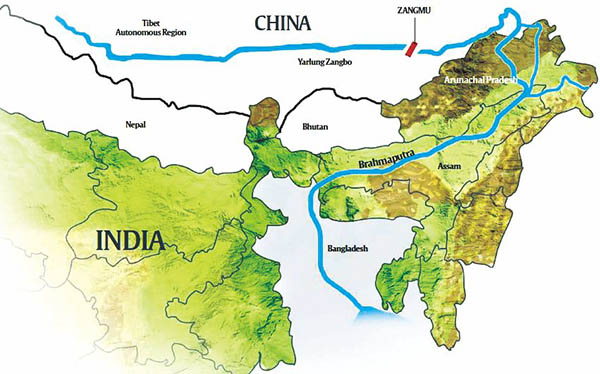China’s Sinister Plans to Dam Rivers
The prospect of having control over the flow of the river Brahmaputra by China is a matter of concern not only for India but also for other downstream nations such as Bangladesh.
Tibet is the water tower from which a number of rivers emanate. Rivers Indus and Brahmaputra (YarlungTsangpo as it is known in Tibet) flow into India which is a lower riparian state.
In the aftermath of border clashes between India and China in the Galwan Valley from May 2020, China had blocked the flow of the Galwan River, a tributary of the River Shyok, which itself is a tributary of River Indus which originates in the Chinese-occupied Aksai Chin area, thus altering the natural course of the river to prevent it from entering India.
China has come up with three large hydropower projects – the Zangmo dam, the Gyatsa dam and the Dagu dam – in very close proximity to each other, within the span of 24 kilometres. The first is already in commission, the second has been constructed and is waiting to be commissioned and the third is the largest of the three and has been in construction since 2017.
Unsafe Exploitation of Hydel Resources
All the three dams have provisions for reservoirs with a combined capacity of almost a billion cubic meters of water. Despite the fact that there is only one village comprising 150 households close to these dams, China decided to undertake such large and costly projects. This has prompted speculation that Beijing’s prime aim behind the projects is to control the flow of the river, besides exporting electricity from Tibet to mainland China.
China has also constructed dams on the Nyang river – a tributary of the Brahmaputra river. These three dams are – Pagsum, Langsai, and Nyang. While these dams are smaller in size, they are still able to hold a considerable amount of water. Also, there are 11 other hydro-power projects on the upper reaches of the Brahmaputra. Moreover, China has already planned for several other dams on the Brahmaputra in the coming ten years at Bayu, Jiexi, Langta, Dakpa, Nang, Demo and Namcha.
In 2016, China has announced that it had decided to block the Xiabuqu river, which is one of the many tributaries of the Brahmaputra on the Chinese side. As per reports, China also has plans to build a dam at Xigase as a part of the Lalho hydro-electric project in the Tibet Autonomous Region. Zhang Yunbao, head of the project’s administration bureau stated that the Lalho project in Tibet represented an investment of $740 million and upon completion will be able to store close to 300 million cubic meters of water, which would be used for ‘irrigation’. However, one can easily speculate on the real intentions of China.
Reports have detailed how China may divert the waters of the Brahmaputra by using tunnels connected to the reservoirs constructed under their hydro-power projects. China’s water diversion plan was revealed after news broke on another Chinese dam construction-13 kilometres upstream from the Tsangmo dam. The finding suggested that the main purpose of this structure was to divert the water from the river and not hydro-power generation. According to media reports, China plans to divert the waters of the Brahmaputra almost 1,100 kilometres away from its original path.
Tibet, with all the rivers that flow through it, can generate 200 million kWh of power, accounting for 30 per cent of the gross hydro-power production of China.
The recent plan for building a major hydro-power project plant on the lower reaches of the Brahmaputra has been put forth in the 14th Five-year plan (2021-2025) of Chinese Communist Party (CCP). The extent of importance China has attached to the project is evident from the statement of the Chairman of the Power Construction Corp. of China, Yan Zhiyong. On the 40th founding anniversary (November 26), Yan stated that the proposed project could be a historic opportunity and could serve to maintain water resources and China’s ‘national security’.
Diverting Waters of the Indus
There is also a thought process in China to go for a smaller ‘pilot’ project: to divert the Indus river towards Xinjiang. It is felt by planners in China that a small-scale project, with low investment and a quickly realizable scheme, could be an ideal pilot project. This diversion will be from the Indus river in Western Tibet to the Tarim Basin in Xinjiang before it enters Ladakh. The project is being referred as ‘the South Western part of Western Route Project’.
The diversion of Indus could strengthen China’s actual control of Aksai Chin which will not be in line with the strategic interests of India.
Between the Indus, which originates in the west of the Tibet plateau, and the YarlungTsangpo-Siang in the East, there are six major rivers flowing from Tibet to India, namely; Sutlej, BhoteKoshi; Arun; Trishuli; Karnali and Gandaki. These rivers are crucial for India’s agricultural and industrial needs. As of 2016, China had plans to build 32 dams on the rivers and tributaries.
China’s plans to divert two trans-Himalayan rivers that sustain millions in downstream regions in India, Pakistan, and Bangladesh and even Nepal are adding to India’s growing concerns due to simmering India China border tension.
Control over the rivers affecting the lower riparian countries effectively gives China a chokehold on India’s economy.
India’s Security Concerns
There are many reasons why a mega hydro-power project so close to the border is a security concern for India. It is feared that after China completes the dam on the lower reaches of the Brahmaputra river in Tibet, it will gain full control of the flow of the river that is the lifeblood of millions of Indians. If at any point, China decides to cut off the water supply, even for a few days, it could prove disastrous for India. Fears reign that amid a conflict or a border dispute, China may decide to stop the flow of the river as a means of retaliation to make India submit to China’s demands.
China could also withhold water in the case of severe droughts, when the water levels of the river are already low, as well as flood low lying areas in Arunachal Pradesh by releasing large amounts of water from the dams at once.
The river Brahmaputra and its tributaries carry more than 30 per cent of the total water resource potential of India. The residents of 22 districts in the Indian state of Assam rely on the Brahmaputra and its tributaries for their livelihood. The river is also extremely important for the transportation of people and materials. During 2013-14, the total number of people that were transported through Brahmaputra’s inland water transport system stood at 70,39,000, and the river was also used to transport 3, 56,552 metric tons of goods. These ferry services also provide employment to over 5,000 people just in the state of Assam.
625 million people live in the Brahmaputra basin, of which, 80% are farmers that need the water from the river for their crops and animals. Bangladesh gets 94% of its water from the Brahmaputra and its tributaries, totalling 2.9 billion metric tons. The high use of water sources is reflected in the agriculturally based economies that come up near the river and how important its waters are.
The newest dam which has been envisaged by China on the lower reaches of the Brahmaputra river in Tibet will also hold back the river silt, which provides essential nutrients to the soil for farming and is the reason for the fertility of the plains of Assam. Further, the Brahmaputra river system and its delta are one of the world’s most ecologically sensitive regions and China’s cot lams could have disastrous ecological consequences.
No Lessons Learnt
All lessons learnt about the negative impact from the impoundment of the Three Gorges Dam (TGD) in the Yangtze River by China have been disregarded. The TGD has disrupted the natural seasonal flow patterns used by fish and blocked or destroyed their breeding grounds. Studies have unravelled the effects of large-scale ecological programmes on ecological rehabilitation of China’s TGD, major ecological issues such as degradation of terrestrial ecosystems in the reservoir area, water quality, aquatic biodiversity and riverbank erosion.
Construction activities undertaken in close proximity of rivers, especially in mountainous areas, cause an increase in suspended particles (rocks, sands, etc) in the river. In 2017, the clear waters of the Siang river had suddenly become extremely muddy. The Siang river originates in the Tibetan plateau and flows into Arunachal Pradesh, where it joins the Lohit and the Dibang downstream to form the mighty Brahmaputra in Assam.
China has also started using polymer resin adhesives during its major construction activities. The resin adhesives are commonly used during large construction activities but are never used in close proximity to water bodies because they are harmful to humans and animals. Till now China has denied all such reports of it planning to build tunnels.
China’s Drinking Water Needs
The rationality of the water diversion plans on China’s part may be understood through shortages of drinking water in the Southern and Eastern regions of China due to prolonged droughts. China’s Ministry of Water revealed on February 4, 2021 that 500,000 hectares of arable land had been affected by the drought and over 300,000 people in rural areas were without a sufficient supply of potable water. The Ministry of Water also added that the region south of the Yangtze River had received 50-80 per cent less water from rainfall since October 2020 and that over 2 million people in Zhejiang, Guangdong and Fujian provinces had been affected.
Tunnels diverting water from the Brahmaputra may provide a solution to its growing problems. However, diverting river routes, especially through its youthful stage, can have devastating effects on downstream nations like India and Bangladesh, as well as on the river dependent flora and fauna – the negative impacts that China seems to be deliberately ignoring.
Water Flow Data Sharing
Though China had, in principle, agreed to provide water flow data of Brahmaputra to India so that the Indian government may aptly prepare in advance if the water level were to rise or fall, it has been untruthful to its word. The two countries have even signed an MoU in 2013 regarding the sharing of water flow data. However, unlike the Indus Water Treaty that India has with Pakistan in terms of water sharing of the Indus river, there are no binding agreements between India and China on Brahmaputra water sharing. China seems to be exploiting the gestation period, before any binding agreement on the Brahmaputra, to ensure its permanent leverage against India. Apart from India, Bangladesh, which is wholly dependent on the Brahmaputra River is concerned with the increasing number of dams that China is building on the Brahmaputra.
Comments
The Chinese government led by Xi Jinping is known to use every dirty trick in the book to advance Jinping’s expansionist and authoritarian ambitions. From intellectual property and technology theft to coercing the developing and low-income countries into a vicious debt trap, the CCP has rigorously been using unscrupulous means to gain a strategic advantage. Having control over cross-boundary rivers are also such potential tools or weapons that are being strategized by Xi’s administration to achieve the strategic goals of China.
As many as 100 million people rely on the Brahmaputra in the region besides numerous aquatic species. The impacts of climate change are already visible in this region and rising temperatures result in the glaciers and snowlines retreating, increasing the possibility of flash floods. China’s indifference towards the ecological ill effects of such massive projects should immediately be taken note of by the international community.


















